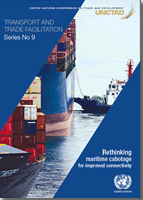
Connectivity is about possibilities for people, companies and countries to connect with each other. In the trade sphere, physical connectivity enables the delivery of goods and services to local, regional and global markets.
Maritime transport connectivity determines the extent to which countries, markets, suppliers, buyers, importers, exporters, producers and consumers are serviced by numerous, various, regular, frequent and reliable maritime transport services. Within the maritime transport sector, the liner shipping connectivity relating to containerised trade is of particular relevance.
Maritime transport connectivity is an important determinant of trade costs. Improved liner shipping connectivity contributes significantly to reducing trade costs and promoting growth in trade volumes.
Many developing countries are faced with various transport and logistical challenges that undermine the level of their transport connectivity and their ability to connect to global markets. In particular, smaller and more vulnerable economies, such as Landlocked Developing Countries (LLDCs) and Small Island Developing States (SIDS), face considerable challenges in benefiting from trade opportunities, as they have access to fewer, less frequent, unreliable, and costly maritime transport connections.
In this context, improving understanding of key factors that can enhance maritime and in particular liner shipping connectivity is critical.
A key factor that is increasingly arising as potentially important for maritime connectivity is the impact of maritime cabotage restrictions. By creating hurdles and bottlenecks that could undermining the smooth delivery of maritime transport services and increase operational costs, maritime cabotage restrictions can be a deterrent to an improved liner shipping connectivity.
Against this background, the present study analyses and discusses various considerations relating to maritime cabotage and the ways in which these can influence the liner shipping connectivity of developing countries, to assist policy]makers in identifying and analysing relevant options that could help leverage maritime cabotage in support of enhanced liner connectivity levels.
This report is structured as follows:
Section 1 introduces the concept of maritime cabotage and considers the different elements associated with maritime cabotage operations.
Section 2 sets out an overview of existing cabotage regimes.
Section 3 discusses the rationale for maritime cabotage restrictions and the impacts of cabotage regimes.
Section 4 analyses the specific impact of cabotage on connectivity and the possibilities of linking existing domestic liner shipping connections with overseas services, based on the time tables of the world’s container shipping fleet as of May 2017.
Finally, the main findings and recommendations of the study are presented in the last section.


